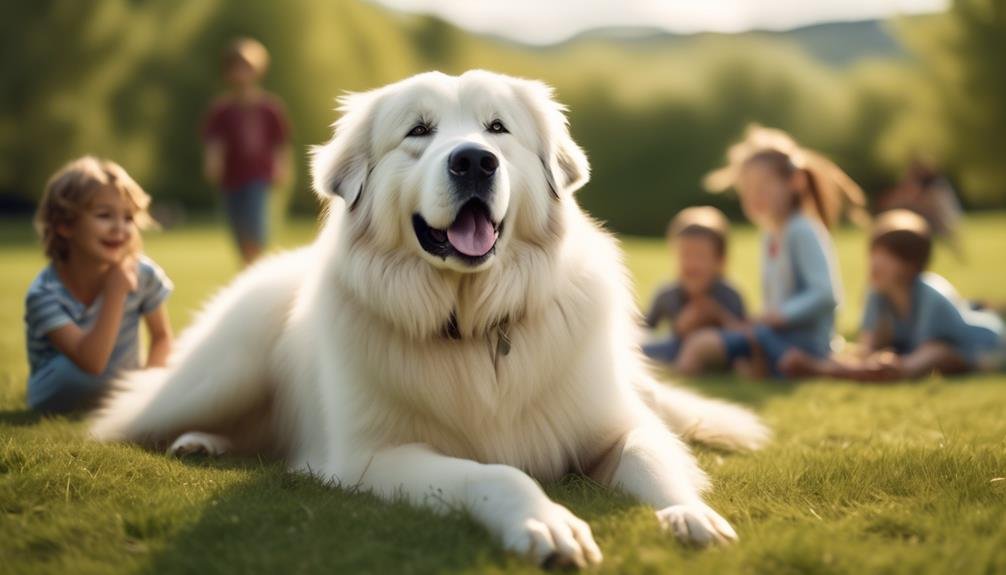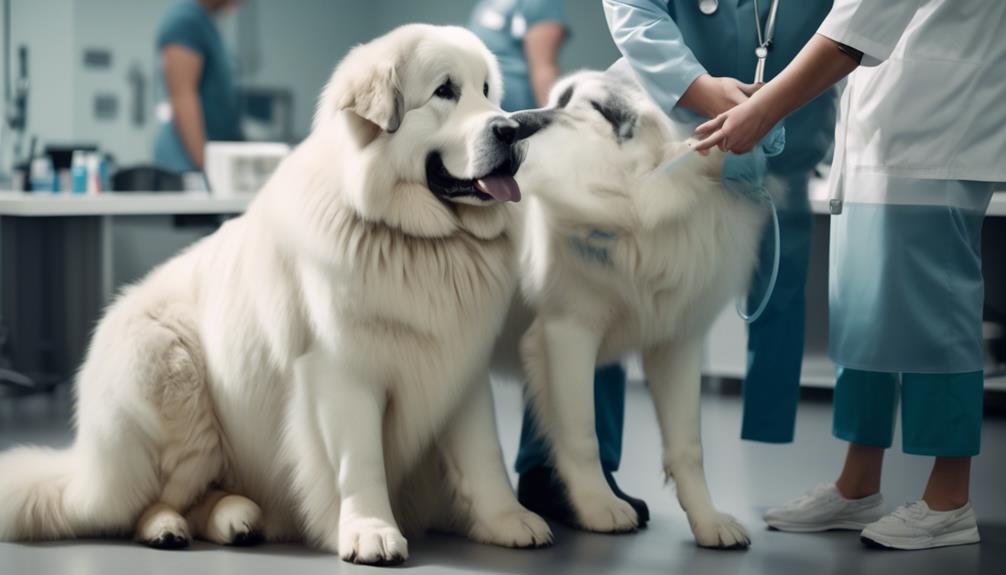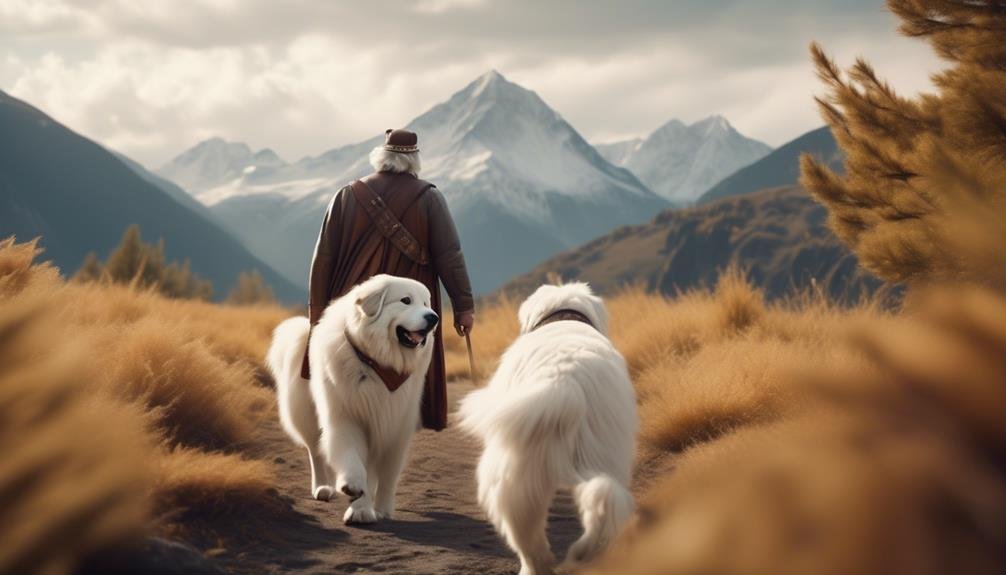With their majestic appearance and gentle temperament, the Great Pyrenees dog breed captures the attention and hearts of many. Originating from the Pyrenees Mountains, this ancient breed possesses a unique combination of strength and loyalty.
But what makes the Great Pyrenees truly remarkable? What are their distinct characteristics and how do they contribute to their role as excellent guard dogs?
In this discussion, let's unravel the fascinating information and explore the captivating world of the Great Pyrenees.
Key Takeaways
- Great Pyrenees are gentle, calm, and loyal dogs that make excellent guard dogs and are good with children and other pets.
- They require moderate exercise, regular grooming, and early socialization and training for well-mannered companions.
- Responsible adoption from rescue organizations or shelters is encouraged, and thorough research should be done when seeking a reputable breeder.
- Great Pyrenees have an independent nature, strong protective instincts, and require firm leadership and patience in training.
Origin and History
The Great Pyrenees breed, with its ancient origins in the Pyrenees Mountains between France and Spain, has a rich and storied history. These majestic dogs have been used for centuries as livestock guardians, protecting sheep and other animals from predators in the rugged mountain terrain. They were highly valued by shepherds for their loyalty, fearlessness, and ability to work independently.
The breed's origins can be traced back to ancient times, and they were recognized by the American Kennel Club in 1933. Great Pyrenees dogs have also played a role in European history, with notable owners including French kings and queens.
Today, they're beloved as companions, known for their gentle nature and protective instincts. Their history is a testament to their enduring qualities and their status as a cherished breed.
Size and Weight

With males standing 27-32 inches tall and weighing 100-120 pounds, and females standing 25-29 inches tall and weighing 85-100 pounds, the Great Pyrenees is a substantial and majestic breed. The size and weight of this breed contribute to its powerful and imposing presence.
Here is a breakdown of the Great Pyrenees' size and weight:
- Males:
- Height: 27-32 inches
- Weight: 100-120 pounds
- Females:
- Height: 25-29 inches
- Weight: 85-100 pounds
These measurements make it clear that the Great Pyrenees is a large and robust dog. The males, in particular, can reach impressive heights and weights, adding to their formidable appearance. Their size and weight also reflect their strength and ability to fulfill their historical role as livestock guardians.
Despite their imposing size, Great Pyrenees are known for their gentle and calm temperament, making them excellent companions for families and individuals alike.
Lifespan

Great Pyrenees typically have a lifespan of 10-12 years. This is a relatively average lifespan for a large breed dog. However, with proper care and attention to their health, some Great Pyrenees have been known to live longer.
Like all dogs, the lifespan of a Great Pyrenees can be influenced by various factors such as genetics, diet, exercise, and overall healthcare. It's important for owners to provide regular veterinary check-ups, a balanced diet, and an appropriate exercise routine to help ensure their Great Pyrenees lives a long and healthy life.
Additionally, early detection and treatment of any health issues can also contribute to extending the lifespan of this breed. Overall, providing a loving and nurturing environment is essential in helping Great Pyrenees reach their fullest potential lifespan.
Coat Colors and Patterns

Coat colors and patterns of the Great Pyrenees vary, ranging from solid white to white with gray or tan markings, or white with yellow markings.
Here are three possible coat color and pattern combinations that you may come across in this breed:
- Solid white: This is the most common and recognized coat color for the Great Pyrenees. These dogs have a pure white, snow-like coat with no markings or patterns.
- White with gray or tan markings: Some Great Pyrenees may have patches or markings of gray or tan on their white coat. These markings can appear on the face, ears, or body, adding a beautiful contrast to their overall appearance.
- White with yellow markings: In some cases, Great Pyrenees may have yellow or cream-colored markings on their white coat. These markings can be found in various areas, such as around the eyes, on the ears, or on the body.
The coat colors and patterns of the Great Pyrenees contribute to their majestic and striking appearance, making them truly stand out in a crowd.
Temperament and Personality

The temperament and personality of the Great Pyrenees breed is known for its gentle and calm nature, making them excellent companions for families and individuals alike.
These dogs are known to be incredibly loyal and protective, making them excellent guard dogs. They have a strong instinct to protect their loved ones, especially children. While they may be reserved around strangers, they are typically not aggressive without reason.
Great Pyrenees dogs have an independent nature and are known to bark a lot, which makes them effective watchdogs. However, they require firm leadership and patience during training, as they can be stubborn at times.
Exercise and Training Needs

After discussing the temperament and personality of the Great Pyrenees breed, it's important to understand their exercise and training needs to ensure their overall well-being and development. Here are three important factors to consider:
- Moderate exercise: Great Pyrenees dogs require regular physical activity to maintain their health and prevent obesity. Daily walks or hikes are recommended to meet their exercise needs.
- Positive reinforcement training: While intelligent, Great Pyrenees can be stubborn at times. It's best to use positive reinforcement methods such as rewards or treats to motivate and train them effectively.
- Early socialization: Early socialization is crucial for Great Pyrenees to become well-mannered and well-adjusted companions. Exposing them to different people, animals, and environments from a young age will help prevent any potential behavioral problems in the future.
Common Health Issues

Common health issues can affect Great Pyrenees dogs, requiring careful attention and proactive management. While they are generally healthy dogs, there are a few conditions that are more commonly seen in this breed. These health issues can have an impact on their overall well-being and quality of life. It is important for Great Pyrenees owners to be aware of these conditions and take necessary steps to prevent or manage them. The table below outlines some of the common health issues that can affect Great Pyrenees dogs:
| Health Issue | Description |
|---|---|
| Hip dysplasia | Abnormal development of the hip joint, leading to arthritis |
| Elbow dysplasia | Abnormal development of the elbow joint, causing lameness |
| Bloat | Life-threatening condition characterized by a twisted stomach |
| Osteosarcoma | Bone cancer that commonly affects large and giant breeds |
Grooming Requirements

To properly maintain the majestic coat of a Great Pyrenees, regular grooming is essential. Here are the grooming requirements for this breed:
- Brushing: Great Pyrenees have a thick, double coat that requires regular brushing to prevent matting and to remove loose hair. A pin brush or slicker brush is recommended to penetrate the dense fur and remove tangles.
- Bathing: While Great Pyrenees are generally clean dogs, they may occasionally require a bath. Use a gentle dog shampoo and conditioner to keep their coat clean and healthy. It's important to thoroughly dry their coat after bathing to avoid moisture-related skin issues.
- Nail Trimming: Regular nail trimming is necessary for Great Pyrenees, as their nails can grow long and become uncomfortable. Use a dog nail trimmer and be cautious not to cut into the quick, which can cause bleeding.
Importance of Socialization

Regular grooming isn't the only aspect of caring for a Great Pyrenees; socialization also plays a crucial role in raising a well-rounded and well-behaved dog.
Great Pyrenees are naturally independent and protective, so early socialization is essential to help them become comfortable and confident in various situations. By exposing them to different people, animals, and environments from a young age, owners can prevent behavioral issues such as fearfulness or aggression.
Socialization helps Great Pyrenees understand acceptable behavior, learn to interact appropriately with strangers, and become more adaptable to new experiences. It's important to introduce them to different sounds, sights, and smells, as well as provide opportunities for positive interactions with other dogs and people.
A well-socialized Great Pyrenees will be more confident, friendly, and adaptable, making them a joy to have as a companion.
Adoption and Rescue Options

Adopting or rescuing a Great Pyrenees can provide a loving home to a dog in need while also experiencing the joys of owning this majestic and loyal breed. For those considering adoption or rescue, here are some options to explore:
- Rescue organizations and shelters: These organizations specialize in finding homes for abandoned or surrendered Great Pyrenees. They assess the dogs' needs, provide necessary medical care, and match them with suitable adopters.
- Breed-specific rescue groups: These organizations focus specifically on Great Pyrenees and have a deep understanding of the breed's unique needs. They often have a network of volunteers who foster and rehabilitate dogs before finding them permanent homes.
- Online platforms: Websites and social media platforms dedicated to pet adoption connect potential adopters with Great Pyrenees in need of homes. These platforms allow individuals to browse and connect with dogs in their area.
Responsible Breeding Practices

Responsible breeders prioritize the health and well-being of Great Pyrenees dogs through ethical breeding practices. They conduct thorough research to ensure they're working with reputable breeders who prioritize the welfare of the dogs. These breeders understand the importance of health screenings for Great Pyrenees puppies and ensure that necessary screenings are conducted to identify potential health issues.
They provide a nurturing environment for their dogs, taking into consideration their physical and emotional needs. Additionally, responsible breeders actively discourage unethical breeding practices and work to raise awareness about the importance of responsible breeding.
Unique Traits and Characteristics

Great Pyrenees possess a variety of unique traits and characteristics that make them stand out among other dog breeds. Here are three notable qualities that set them apart:
- Independent and Protective Nature: Great Pyrenees have an independent streak and strong protective instincts. They're known for their ability to guard their families and properties, making them excellent watchdogs. Their loyalty and devotion to their loved ones are unmatched.
- Gentle and Calm Temperament: Despite their large size, Great Pyrenees have a gentle and calm demeanor. They're known to be patient and tolerant, making them great companions for children and other pets. Their calm nature also extends to their interactions with strangers, as they're typically reserved but not aggressive without reason.
- Majestic Appearance: Great Pyrenees have a majestic and noble appearance that commands attention. With their thick, double coat and regal posture, they exude elegance and grace. This, combined with their large size, contributes to their popularity and appeal among dog lovers and celebrities alike.
Famous Great Pyrenees Owners

With their unique traits and notable characteristics, it's no wonder that Great Pyrenees dogs have captured the hearts of numerous famous owners, including Hollywood actress Jennifer Anniston. Anniston, known for her love of animals, adopted a Great Pyrenees mix named Chesterfield.
But Anniston isn't the only celebrity to be enamored by these majestic canines. Great Pyrenees dogs have become popular among many famous individuals due to their noble appearance, loyalty, and protective nature.
Their gentle and calm temperament, combined with their ability to get along well with children and other pets, makes them excellent companions for celebrities who lead busy lives.
Additionally, famous owners of Great Pyrenees dogs can help raise awareness about the benefits of adopting these magnificent animals and encourage others to consider giving them a loving home.
Frequently Asked Questions
Are Great Pyrenees Good With Small Children?
Yes, Great Pyrenees are good with small children. They are gentle, calm, and loyal, making them excellent companions for kids. Their protective instincts also ensure the safety of the little ones.
How Much Do Great Pyrenees Shed?
Great Pyrenees shed a lot due to their thick double coat. Regular brushing and grooming is necessary to manage the shedding. However, shedding can vary between individual dogs.
Can Great Pyrenees Live in Apartments or Small Homes?
Great Pyrenees can live in apartments or small homes, but they require regular exercise and mental stimulation. They are a large breed with an independent nature, so owners must provide sufficient space and opportunities for them to thrive.
Do Great Pyrenees Get Along Well With Other Dogs?
Yes, Great Pyrenees generally get along well with other dogs. They have a gentle and calm temperament, making them good companions for other pets. Proper socialization and training are essential for harmonious interactions.
Are Great Pyrenees Suitable for First-Time Dog Owners?
Great Pyrenees are not recommended for first-time dog owners due to their independent nature and stubbornness. They require firm leadership and patience in training. However, with proper guidance and socialization, they can make loyal and loving companions.
What Are the Similarities and Differences Between Great Pyrenees and Leonberger Dog Breeds?
The Great Pyrenees and Leonberger dog breeds share similar leonberger dog breed characteristics such as their large size and gentle nature. However, they also have differences in their coat colors, with the Great Pyrenees being predominantly white while the Leonberger can have a wider variety of coat colors.
Conclusion
In conclusion, the Great Pyrenees dog breed is a majestic and loyal companion. With their gentle temperament and strong protective instincts, they make excellent guard dogs and provide love and companionship to their owners.
Their unique coat colors and patterns, along with their independent nature, add to their charm. Whether adopted from rescue organizations or obtained from responsible breeders, Great Pyrenees dogs bring joy and a sense of security to their families, like a steadfast mountain guarding its treasures.




